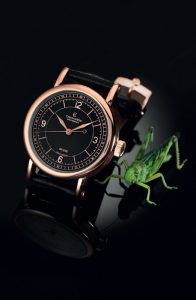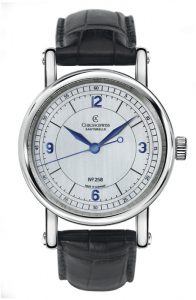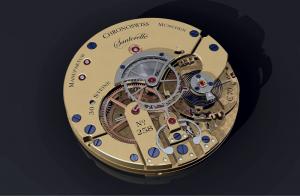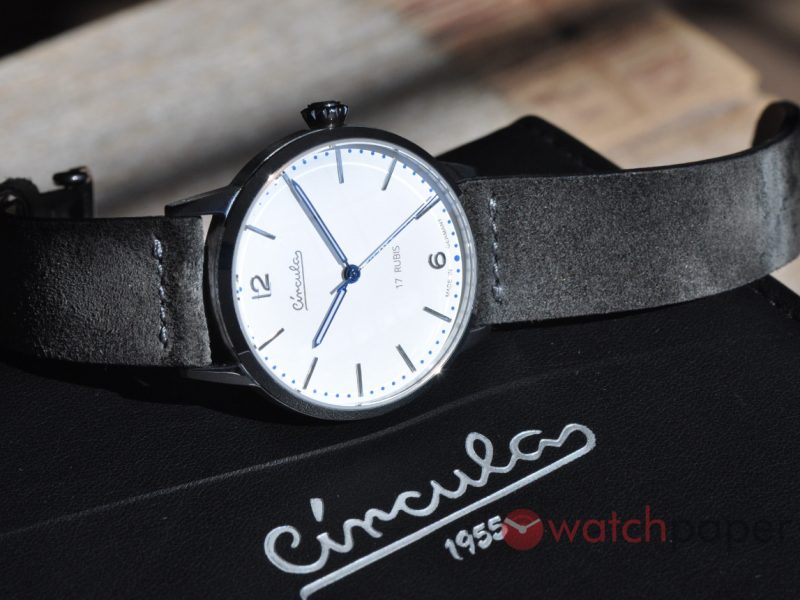CHRONOSWISS Saturelle Ticking Beauty with a Spring in its Step
The Sauterelle sets the scene for a freshly developed manufacture caliber
Great events proclaim their coming in advance—after the spectacular announcement at Baselworld 2008 that Chronoswiss would be manufacturing its own movements within two years, 2009 sees Gerd-Rüdiger Lang already making his promise a reality. The brand is well on its way—you could say one “jump” ahead of the game—to becoming a manufacture. The Sauterelle is Chronoswiss’s first model with an in-house manufacture caliber—“Made in Germany.” Thus, Chronoswiss makes a clear distinction between the limited historical manufactory calibers utilized to this point and the Sauterelle, a completely new development that represents the first step on the brand’s path to becoming a true manufacture.
This caliber ticks not only in one watch, but more precisely, in two model variations, putting the connoisseur in the predicament of having to choose. The Sauterelle is available both as a classic three-hand watch (with either black or white dial) or with an unusual regulator dial that is reminiscent of the brand’s origins.
“Whoops! What’s wrong with that second hand?” This astonished query might spring from the lips of those who take a cursory glance at Chronoswiss’s new wristwatch. Has Gerd-Rüdiger Lang thrown his noble principles overboard? Is he suddenly turning his back on the “fascination of mechanics” that has been successfully celebrated at Chronoswiss for more than 25 years? Is the fallout from the financial crisis forcing him to use the electronic calibers that master watchmakers have always shied away from in their passion for classically ticking movements? We wanted to nip such rumors in the bud: naturally, not a word of all that is true; Chronoswiss still holds fast to its iron principles. However, to clear up any possible misconceptions it is best to explain: even though the latest creation emerging from Chronoswiss’s workshop catches the eye with its precisely jumping, centrally positioned second hand, oscillating quartz will not darken the door of the distinctive Chronoswiss watch case. Everything is—and shall remain—purely mechanical.
In the new Sauterelle, a word that means “grasshopper” in English, the very large balance with its variable torque and accompanying Breguet overcoil balance spring complete 18,000 semioscillations per hour (2.5 Hz)—just like in the good old days. In these hectic times we like to call this skillful deceleration—actually a really good fit with Gerd-Rüdiger Lang, who one can confidently say is calmness and composure in the flesh. A conventional second hand would move forward in leisurely steps of one-fifth of a second; the fact that this hand marches forward only every full second with stately precision is due to the sophistication of the movement, which was developed in cooperation with watch technician Karsten Frässdorf. Its basic function is the same as that of any other mechanical caliber except that it possesses an additional small gear train, whose wide pallet lever and accompanying escape wheel feature prominently on the back. It counts five semi-oscillations of the balance in tandem with a small spring, which only then allows the second hand to make its precise jump to the next division mark on the corresponding scale around the edge of the extraordinarily clean dial. Identical numbering graces dial, case, and movement.
As is so often the case, it was helpful during the conception phase of this remarkable watch to look back into the past. Pocket watches with jump seconds, known in watchmaking parlance as seconde morte, have been around since the late eighteenth century. This system can also already be found in wristwatches: during the second half of the 1940s, movement blank manufacturer Ébauches Chézard developed an 11½-line caliber family whose unique characteristic was the jump second. This “device for moving the second hand of a watch movement forward in steps” was patented in Germany on June 3, 1949. The ébauche was available in two different versions around 1955, followed later by a simplified version.
The above-mentioned development and the brand new manufacture caliber by Chronoswiss are, however, worlds apart, both technically and with regard to craftsmanship. This newest member of the Chronoswiss family is, after all, state-of-the-art, and as always, design concepts passed down through the years go hand-in-hand with interesting horological innovations. The fascinating jump second mechanism can certainly be regarded as just such an innovation and justifiably counted as a complication: forced control occurs with the help of an easy-to-set initial tension spring, and because its construction is so well thought out, it cannot become misaligned or “hiccup.” Chronoswiss has also thoroughly eliminated the galloping often observed in this movement’s ticking forefathers.
Ease of maintenance is of utmost importance, and in that respect Chronoswiss has come up with an ingenious idea: the Sauterelle has an integrated “spare-parts storage area” located inside the movement between the barrel bridge and the third-wheel bridge. Sixty hours of power reserve gives it almost three days’ worth of energy. The movement is designed to be especially longlasting with rolling cycloid gearing that is energy-efficient and creates less wear and pinions crafted from fully hardened steel (Vickers hardness of approximately 630). Other friction-reducing elements include gears crafted in hardened beryllium bronze (approximately 380 on the Vickers scale). The impressive energy efficiency of the ensemble allows a weaker mainspring to be employed, causing less pressure and friction in the pivot bearings and resulting in less wear overall. Speaking of the mainspring, a special type is utilized that cannot unwind eccentrically.
Because the coils no longer rub against one another, the stored energy relieving the gear train can once again be reduced by ten percent. Conical pivots for the pallet lever and escape wheel as well as domed and olive-cut bearing jewels also reduce the friction that is so detrimental to a watch movement. As opposed to escapements widely used today, the classic Swiss lever escapement has an impulse angle of only 42 degrees, which allows the use of wider pallets resulting in more uniform energy transfer and a longer path.
In spite of its considerable 16 mm diameter, the balance wheel is surprisingly light with a mass inertia of 108 mgmm². A balance of the same size beating at a frequency of 28,800 vph would need approximately five times the power to perform the same task. It is not possible to shift the regulating screws accidentally because they are press fitted, and along with four smaller weighted screws, have been aerodynamically sunk into the balance rim. It almost goes without saying that the Straumann-Breguet balance spring—incredibly rare today—oscillates absolutely freely, resulting in extremely high precision. This subgroup contains no index—it would just be in the way anyway—and regulation of the oscillation system occurs via the adjustable balance torque.
According to traditional watchmaking artisanry, the screws are all polished flat and not galvanized. To ensure more accurate height adjustment and oil retention, the bearings for the escape wheel, pallet lever, and balance all have cap jewels.
With manual winding manufacture Caliber C.70/C.71, Chronoswiss has given a new face to the valuable commodity of time and reached a milestone on the road to becoming a manufacture. The movement as a whole exudes tradition and precision craftsmanship, as evidenced by a glance through the sapphire crystal case back of the lavish case, available in purist steel or elegant red gold. With each tick, the Sauterelle shows its mettle—a breakthrough for Chronoswiss as the company “jumps” toward becoming a manufacture. With this development, Chronoswiss both blazes its own trail and proves its entrepreneurial courage.





